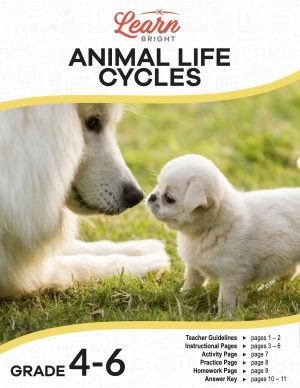Description
What our Quantitative Relationships lesson plan includes
Lesson Objectives and Overview: Quantitative Relationships discusses dependent and independent variables and how they relate. At the end of the lesson, students will be able to identify and define the independent and dependent variables, create an equation from a table or graph, and be able to move fluidly between quantitative relationships. This lesson is for students in 6th grade.
Classroom Procedure
Every lesson plan provides you with a classroom procedure page that outlines a step-by-step guide to follow. You do not have to follow the guide exactly. The guide helps you organize the lesson and details when to hand out worksheets. It also lists information in the blue box that you might find useful. You will find the lesson objectives, state standards, and number of class sessions the lesson should take to complete in this area. In addition, it describes the supplies you will need as well as what and how you need to prepare beforehand. The supplies that you will need for this lesson include tennis balls, large poster paper, and rulers, yard sticks, or measuring tapes.
Options for Lesson
Included with this lesson is an “Options for Lesson” section that lists a number of suggestions for activities to add to the lesson or substitutions for the ones already in the lesson. One optional addition to this lesson is to have your students measure any changing variables in the classroom, such as the temperature or the time it takes them to go a certain distance running, walking, or crawling. One optional adjustment to the lesson activity is to have your students use different kinds of balls and test the equations.
Teacher Notes
The teacher notes page includes lines that you can use to add your own notes as you’re preparing for this lesson.
QUANTITATIVE RELATIONSHIPS LESSON PLAN CONTENT PAGES
Quantitative Relationships
The Quantitative Relationships lesson plan includes three content pages. The word “quantitative” refers to the ability to measure the amount of something. Variables are something that can be changed. In quantitative relationships, two variables—the independent variable (x) and the dependent variable (y)—create a relationship that you can measure. Independent variables are changed or altered in some way. Dependent variables are the variables that you measure.
Let’s say you planted a large garden with three rows of lettuce. You used a different kind of fertilizer on each row of lettuce, and you measure the growth of each row of lettuce each week. In this example, the type of fertilizer is the independent variable and the growth of the lettuce is dependent variable.
The fertilizer leads to the growth, just like independent variables leads to or changes dependent variables. Once you collect your data, you can create a graph or table and an equation.
Example 1
Let’s look at another example. Kaia plays the trumpet in the school band. The band is going on a field trip, so they need to raise money. The band fundraiser is selling boxes of chocolates and Kaia is excited! Each box sells for $10.00. Kaia sells boxes to her family and friends.
The first step is to identify the independent and dependent variables. The number of boxes sold leads to or changes the amount of money raised, so the number of boxes is the independent variable. Therefore, the dependent variable is the amount of money.
The second step is to create a table that expresses the changes in the variables. The lesson shows this table, with Number of Boxes (x) on the left and Amount of Money (y) on the right.
The third step is to draw a graph using the data from the table. This graph has the independent variable (x) on the x-axis and the dependent variable (y) on the y-axis. To find the points for the graph, you use the data from the table to create data points (x,y). For this example, the points for are (0,0), (1,10), (2,20), (3,30), and (4,40).
Next, let’s write an equation to for the amount of money (m) that will be collected if (b) boxes of chocolate bars are sold. To write an equation, ask yourself how x changes to produce y or what the rule is by which x changes to equal y. For this example, the number of chocolate bars is multiplied by 10 to find the amount of money raised. Therefore, the equation is 10b = m, where b is boxes sold and m is amount of money raised.
To review, the four steps are: 1. Identify the independent and dependent variables; 2. Create a table; 3. Draw a graph; and 4. Write an equation.
Example 2
Let’s take a look at another example. Hannah learned from her personal trainer that staying active will increase the length of her life. Knowing this, Hannah decides to spend 30 minutes each day exercising.
Let’s follow our steps to solve. First, identify the independent and dependent variables. In this example, the independent variable is days and the dependent variable is exercise time.
Second, create a table to express the changes in these variables. Third, draw a graph using the data from the table.
Finally, write an equation where d is the number of days and m represents the total minutes of exercise in a given time frame. The equation is 30d = m.
QUANTIATIVE RELATIONSHIPS LESSON PLAN WORKSHEETS
The Quantitative Relationships lesson plan includes four worksheets: an activity worksheet, a practice worksheet, a homework assignment, and a quiz. You can refer to the guide on the classroom procedure page to determine when to hand out each worksheet.
TENNIS BALLS ACTIVITY WORKSHEET
Students will work with a partner to complete the activity worksheet. Each pair will work together to solve a word problem about a tennis ball company. The pairs will collect their own data by dropping a tennis ball from different heights and counting the number of times it bounces. They will then identify the independent and dependent variables, fill in a table, create a graph, and write an equation for the problem. They will also explain their equation using words.
WORD PROBLEMS PRACTICE WORKSHEET
For the practice worksheet, students will solve two word problems by identifying the independent and dependent variables, filling in a table, creating a graph, and writing an equation for each.
QUANTITATIVE RELATIONSHIPS HOMEWORK ASSIGNMENT
Like the practice worksheet, the homework assignment asks students to solve two word problems by identifying the independent and dependent variables, filling in a table, creating a graph, and writing an equation for each.
QUIZ
This lesson also includes a quiz that you can use to test students’ understanding of the lesson material. Like the practice worksheet and homework assignment or the quiz, students will solve a word problem by identifying the independent and dependent variables, filling in a table, creating a graph, and writing an equation.
Worksheet Answer Keys
This lesson plan includes answer keys for the practice worksheet, the homework assignment, and the quiz. If you choose to administer the lesson pages to your students via PDF, you will need to save a new file that omits these pages. Otherwise, you can simply print out the applicable pages and keep these as reference for yourself when grading assignments.









